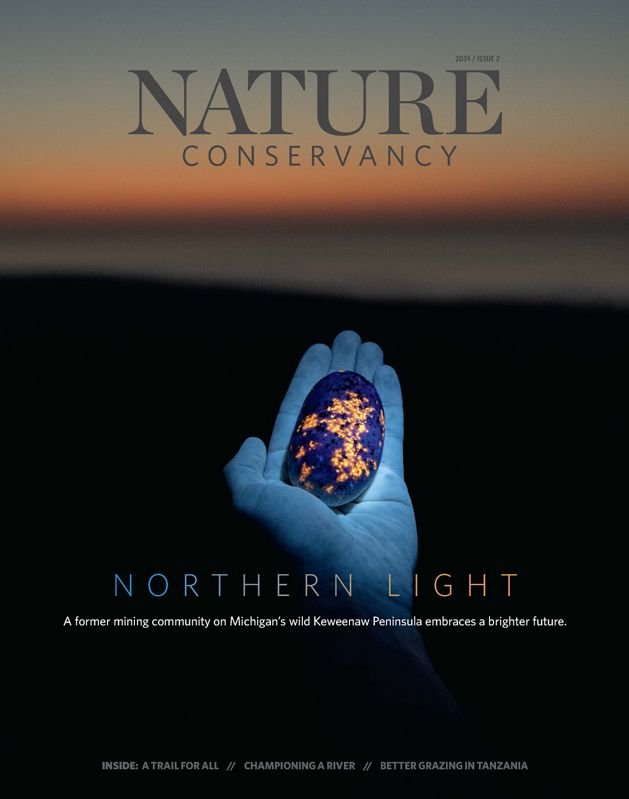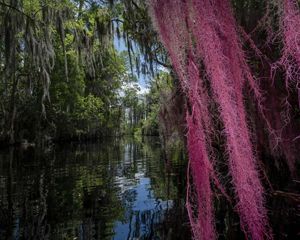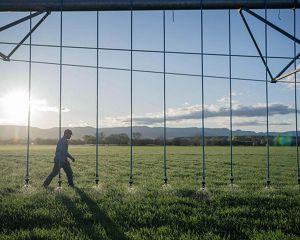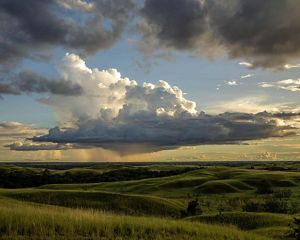A Forest for the Next Generations
Native communities in Alaska are leading a rebirth by reclaiming Indigenous authority and restoring culture, forests and local economies.
Text by Jenna Kunze | Photographs by Bethany Sonsini Goodrich | Issue 3, 2024

As part of their summer jobs, three teenagers—members of the Prince of Wales Alaska Youth Stewards work crew—are being asked by Quinn Aboudara to become time travelers. Stay with him here.
They’re standing at the foot of a tumble of rocks and uprooted trees that was the result of a 2020 landslide on Prince of Wales Island in Southeast Alaska. Aboudara, 41, grew up down the street and was raised by the land’s original stewards—the Tlingit & Haida people who have lived in the area since the last Ice Age. When he was the same age as his crew of local teens, this spot was a salmon spawning stream. Since he knows what it was, he also sees how it can be restored.
“I want you to start looking at the lands as they are now, and start envisioning what they’ll look like in 10, 20, 40 years,” says Aboudara, the natural resource coordinator for Shaan Seet Incorporated, the local Native village corporation.
As part of their 10-week summer job, the Alaska Youth Stewards are working with Aboudara and land managers like him on natural resource and cultural stewardship projects to gain job experience and leadership skills. Each crew member wears XtraTuf rain boots and high school sports sweatshirts with their name printed on the back.
“Every landslide has the potential to become a stream, and every stream has the potential to be a fish-bearing stream,” Aboudara says, redirecting the crew’s attention to a pool of water with mayflies in it—fish food. “We want you to start looking into the future and seeing a time when you have more fish, your children have more fish, your children’s children’s children’s children have more fish, than what we have today.”
As part of their job description, these young adults are building that future. They are working to stabilize the banks and restore the stream in an area where old-growth trees were decimated by logging in the past century. Losing those trees helped precipitate major landslides like this one. The restoration starts with surveying the site; work begins as the teens inch up the landslide on foot. Aboudara distributes tools to the crew: Laci Lowery, an 18-year-old Haida woman, peers through the scoping tool while her Tlingit & Haida relative, Allison Mills, 17, holds one side of the measuring tape and Connor Bagby, 15, brings the other side to the opposite embankment, shouting the measurements back to Aboudara.
The program is much more than a typical youth internship experience. It is one part of a 15-year-old Indigenous-led collaboration known as the Sustainable Southeast Partnership (SSP), which was launched with support from The Nature Conservancy, in part to help local communities develop stable, sustainable alternatives to logging as that industry—and many of its high-paying jobs—has faded from this landscape. A number of the region’s most influential organizations—a consortium of the Tlingit & Haida communities and the regional Native corporation, Sealaska—have also been major supporters of Alaska Youth Stewards and SSP.
Now, zoom out to the treetops. Then even farther, to the big-picture view of more than 30 communities spread throughout the forested archipelago that makes up Southeast Alaska’s panhandle. From this vantage point, you’ll see another, integral type of restoration in action: the restoration of a people, and of Indigenous-led stewardship in Southeast Alaska—the first step toward undoing centuries of social, cultural and environmental damage.
What many people call Southeast Alaska—part of the largest intact temperate rainforest in the world—the Tlingit & Haida and Tsimshian call home. It’s midsummer in Klawock, a community on Prince of Wales Island, and the natural wealth the Tlingit & Haida have long defined themselves by is on full display. The salmon are just beginning their journey back to their birthplace to spawn. Bald eagles chatter with one another overhead, fawn wobble on unsure legs beside their mothers, and salmonberries and blueberries decorate the green landscape like Christmas ornaments.
Southeast Alaska comprises more than 35,000 square miles of land, an area larger than the state of Maine. The region consists of massive islands, icy bays, narrow straits and towering mountains that make up the giant Alexander Archipelago.
Today, the majority of the land here is managed by the U.S. government as the Tongass National Forest. At more than 26,000 square miles (16.7 million acres), the Tongass is by far the largest unit in the Forest Service—three times larger than any other national forest.
The federal government took these lands from Alaska Native people in the early 1900s, when President Theodore Roosevelt designated the area as a forest reserve, which soon became the Tongass National Forest. The Central Council of the Tlingit & Haida Indian Tribes of Alaska—along with other Alaska Native communities—were permitted to sue the government in 1935 over the loss of their lands. But it wasn’t until 1971 that Congress passed the Alaska Native Claims Settlement Act, in which Alaska Native leaders agreed to extinguish their land claims in order to retain around 45 million acres of land, almost a billion dollars and shares in 12 newly created regional for-profit Native corporations throughout the state. The formation of for-profit corporations to hold ancestral lands—and their mandate to generate dividends for their Indigenous shareholders—incentivized the commercial development of Native lands in Alaska, from the oil fields of the North Slope to timber-rich Southeast Alaska. It was a dramatic shift away from how Indigenous communities had historically managed their lands.
Preserving Wild Alaska
Learn moreIn Southeast Alaska, the profitable industry and focus of regional Native corporation Sealaska was timber, says Joel Jackson, the tribal president of the Organized Village of Kake, which sits about midway down the archipelago. “Most of the people who got land basically did what we did—we extracted all the timber off our land,” he says. “That was a way to make money and employ our people. So that’s what we did, and we paid the price for it for years.”
The Tongass was the local focal point of a wider movement that became known as the “timber wars,” an ongoing series of conflicts that began in the 20th century and carry lingering controversy for many locals. In the 1950s, the Forest Service, seeing the forest’s industrial potential, set up two 50-year timber contracts to sell local old-growth Sitka spruce and western hemlock trees to large-scale pulp mills. In the 1980s and ’90s, a wider confrontation took shape between environmentalists and the timber industry. So began conservation groups’ decades-long efforts to shut down mills, sue logging companies and cancel the logging contracts. From Northern California to Alaska, protesters lined up against tree fellers and heavy-equipment operators. In all the noise, notably, Indigenous perspective and nuance were missing. But many local communities, now heavily dependent on logging for good-paying jobs, often found themselves at odds with efforts to close the timber mills.
By the turn of the century, the Forest Service and Alaska Native corporations had logged up to 34% of productive old-growth timber in some parts of Southeast Alaska. The result was economically and environmentally devastating. When the federal government terminated its contracts with the two remaining pulp mills, many community members lost their jobs.
Clearcutting contributed to a whole host of environmental issues, according to a 1985 report from Alaska’s Department of Fish and Game. Removing old-growth forest degraded deer habitat and allowed silt to build up in streams, which spoiled salmon spawning grounds—both animals provide an important source of food for remote Indigenous communities.
Forest Check-Up




At the same time that the Tongass’ old-growth trees were being removed, an even more precious resource was being taken from this region: its children and their culture. From the mid-1800s through the 1970s, federal policies, initiated by the 1819 federal “Indian Civilization Act” and later perpetuated by the Bureau of Indian Affairs, codified mass separation of Native kids from their families, communities, languages, customs and traditions in favor of Western assimilation, according to a recent federal investigation into Indian boarding school history published in May 2022 by the Department of the Interior.
Even decades later, when Quinn Aboudara and his peers were in high school on Prince of Wales Island, Alaska Native culture was still largely absent in the classroom setting. The boarding-school generation, now elders, were punished for speaking their Native languages and practicing their traditions in school. As a consequence, the elders often didn’t teach their own children in order to protect them, further separating the younger generation from their culture and identity.
It was a challenging time. After the timber bust, says Aboudara, “we were left without jobs, without ambitions, without goals, without a future.” Local businesses shut down, and the school’s population dwindled in what he calls a mass exodus.
The degradation of Southeast Alaska—environmentally, economically and culturally—had come from the outside in. So in an effort to rebuild self-sufficient and healthy communities, in 2012 tribal governments, business owners, fishermen and conservation nonprofits including The Nature Conservancy came together to form a sustainable solution from the ground up.
Welcome to culture camp: where Indigenous communities start healing
The woody scent of smoked salmon fills the air down by the beach, where the village of Kake holds its annual culture camp. For seven days, local kids from the community of Kake learn from nearly every generation above them how to process local foods—including freshly caught halibut, deer and salmon. They also sew pelts, practice traditional song and dance, camp on the land, and wake up at 4 a.m. to harvest gumboots—a local shellfish—during low tide.
Kake’s tribal president, Joel Jackson, 67, is wearing a T-shirt celebrating the 35th year of culture camp—a program he describes as “life-saving”—while he oversees kids loading up on a school bus to go home for the day. Jackson remembers a time decades earlier when his village and its people were shell-shocked from the post-logging bust. Kake’s per capita suicide rate led the country. Jackson remembers the words of an elder: “The only people that can help us is ourselves.”
For the Tlingit & Haida people, the land is so intertwined with a sense of identity, and both had been stripped away in recent history. Recognizing that helped organizers to “get a hold of our people,” Jackson says.
Starting with reintroducing culture, the leaders prioritized traditional values and on-the-land healing, he says. The youth “learn respect for themselves and for each other.”
The culture camp itself—where nine local kids stay overnight for one week in summer months, and dozens of younger children are bussed in by the tribe daily—is a living example of community-driven solutions. Zooming out, the effort to reconnect community, culture, people and place isn’t limited to one community, but has taken root across Southeast Alaska.
Culture camps, youth programs and similar initiatives across the region were built by community members who wanted something better for the next generations after boom-and-bust industries left them empty-handed. That was the idea behind the Sustainable Southeast Partnership. The SSP, as it’s called by locals, was founded in 2012 when local entities—industry, conservation groups and, for the first time, Indigenous organizations—came together with the common goal of rebuilding healthy economies and communities in Southeast Alaska.
Initial conversations were hampered by the long-standing enmity between logging companies and conservationists. That’s when Alaska Native leaders stepped up to call for a tribal-led, sustainable collaboration.
“If you move forward on a base of trust and strong values, you can paint a bigger vision of success with our communities, instead of for them,” says Anthony Gunnuk’ Mallott, the former CEO of the Sealaska Corporation.
Based on each community’s self-identified priorities, the SSP created initiatives supporting food security, energy independence, sustainable management of forests and fisheries, and building a localized economy. “You might notice that, in this whole thing, ‘conservation’ isn’t really highlighted at all,” says Bob Christensen, an ecologist and one of the founding members of the SSP. “And that’s odd for an entity like The Nature Conservancy, [whose] mission is to practice conservation.” But the key, he says, is that conservation is a part of every project.
Initially, the SSP ran on temporary philanthropic support. But that changed in 2021, after Sealaska, the regional Alaska Native corporation with more than 25,000 largely Indigenous shareholders, ended old-growth logging on its lands and enrolled 165,000 acres of forest—an area 10 times the size of Manhattan—in carbon markets. That same year, Sealaska used some of the proceeds from the carbon deal to provide a $10 million seed investment in the Seacoast Trust, an endowment that—once fully funded—will provide stable funding for the SSP from its earnings. Along with a half-dozen other donors, the fund now tops out at more than $24 million.
Crystal Yankawgé Nelson, a Tlingit woman from Juneau, Alaska, has worked for TNC for six years in community development and leads healing committee work on behalf of SSP as a partner. She sees a direct connection between supporting the cultural health of communities and the health of the land. “For Indigenous people to have more capacity for conservation work, we need to be healthy. So our communities need to be healthy enough to step into those roles.”
This is why we do restoration
In contrast to Aboudara, 17-year-old Allison Mills has always known she wanted to work in the forest. Hanging in her father’s Sealaska office is a drawing she created as a first-grader. It says, “When I grow up, I want to be a tree thinner.” Below it, there’s a crayon self-portrait of her holding two logs. Since she created the drawing about a decade ago, local forest management style has changed toward restoration. Mills now sees her job as helping to “keep the forest alive.”
It’s an opportunity that some of her ancestors weren’t afforded—and one that trends back toward the symbiotic relationship communities here used to have with the land, says Nelson.
By the middle of summer, the team of youth stewards that Aboudara mentored has already worked on salmon stream restoration, maintenance on an old logging road converted into a trail, and historic site cleanups. They also spent a week working with a local Forest Service archaeologist to clear alders that were obstructing historic mining equipment at the Salt Chuck Mine.
Aboudara hopes that by engaging youths to steward their lands through this and other programs aimed at young adults, such as the Klawock Indigenous Stewards Forest Partnership program, which he also directs, they’ll have a leg up in professional connections. Throughout these programs, students work with professionals from tribal governments, municipal governments, conservation organizations, Native corporations and federal agencies such as the Forest Service to direct their work.
“We’re the ones who everybody’s looking at, going, ‘Fix this,’” says Aboudara. “So here we are, fixing it. Ultimately that is the overarching goal with Alaska Youth Stewards and these other community programs, that we raise students from being students to becoming leaders within their communities.”
And since the program’s creation in 2017, it seems to be working. These young adults, the progeny of the program, are taking their knowledge and Indigenous worldviews and applying them to jobs both locally and out of state. Talia Davis is a 25-year-old Tlingit woman from Kake who was a crew member in the first iteration of Alaska Youth Stewards back in 2017. Now, Davis is getting her master’s degree in plankton biology in Oregon, having spent two years working for the federal government in fisheries management. She’s home to help with culture camp, teaching the younger generation—including her siblings—how to clean and prepare fresh-caught salmon.
On a larger scale, Davis understands the power of growing community members into local decision-makers. “That’s my goal. We should be the ones making the management decisions on the area that we live in and depend upon,” she says. “I think it’s gonna take a couple of generations. Until [then], Indigenous voices need to be more prominent in spaces where they’re making these decisions.”
On this mid-July morning, the Youth Stewards crew is going netting for sockeye salmon on Klawock Lake. Aboudara has doled out roles ahead of time, giving each teen a job to fulfill. He maneuvers the double-wide skiff up the Klawock River, keeping his eye out for signs of salmon. Earlier this summer, the teens had worked to restore logging-era damage to several salmon spawning streams. Now they are out on the water to test the success of their work.
Thirty minutes later, they spy their target. Mills helps pull the net’s lead line. Conner Bagby disturbs the water, sending bubbles down below and scaring salmon into the seining net. Laci Lowrey helps Aboudara pull in the net’s lead lines, and fast, before the fish have time to swim out of their entanglement. High fives all around when they pull up a catch. By the time they head to shore, the crew has caught and fileted eight sockeye salmon for their dinner.
“This is why we do restoration,” Aboudara says as Mills slices through the belly of the salmon, pulling out fistfuls of roe. On the dock, children are jumping off into the water below on a 70-degree day, their excited screams suspended the whole way down. “When people ask why we do this work, tell them this is the why.”
About the Creators
Bethany Sonsini Goodrich is a Southeastern Alaska photographer. She directs a Storytelling for Change program that supports rural and Indigenous storytellers.
Jenna Kunze is a staff reporter for Native News Online, where she covers Indigenous communities across the United States.

Magazine Stories in Your Inbox
Sign up for the Nature News email and receive conservation stories each month.













